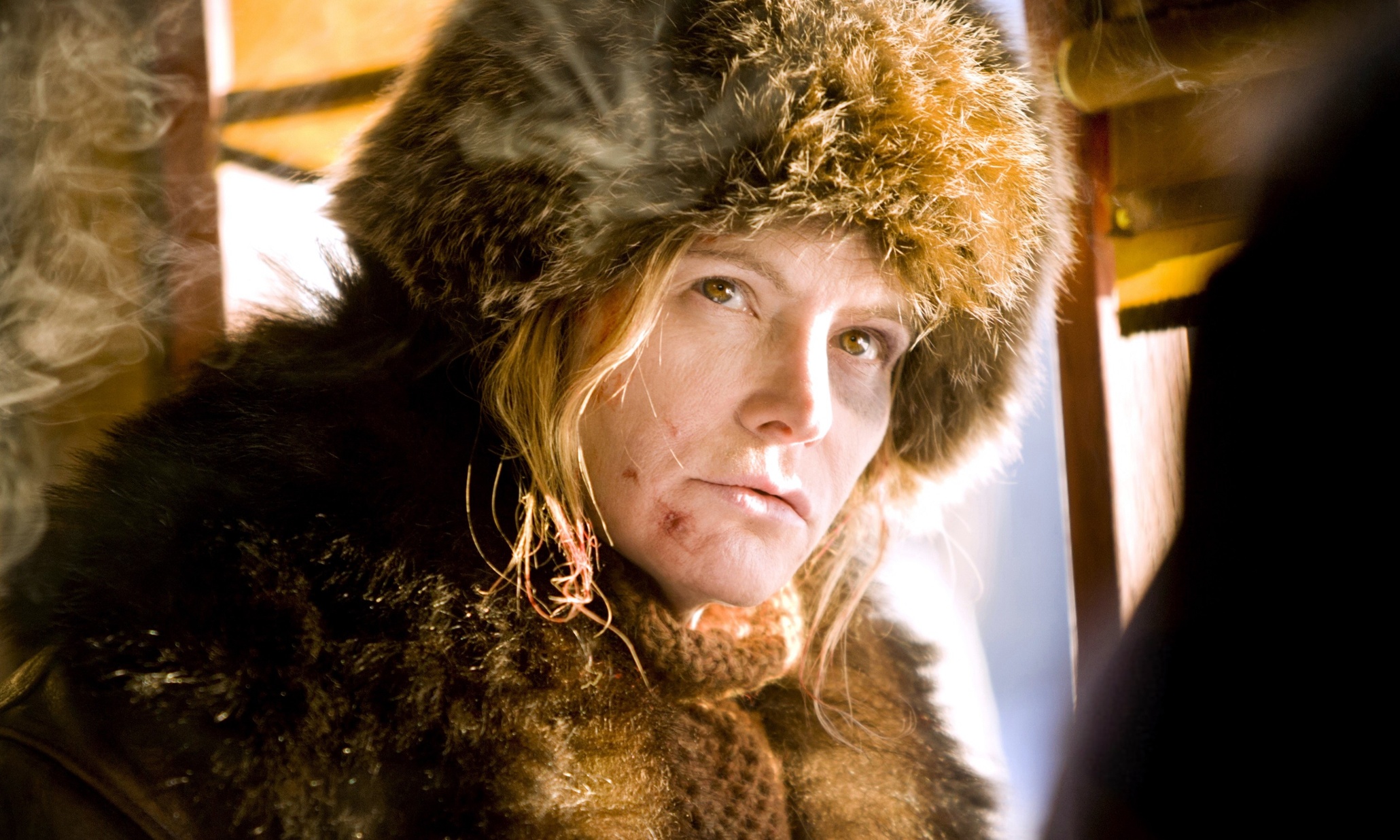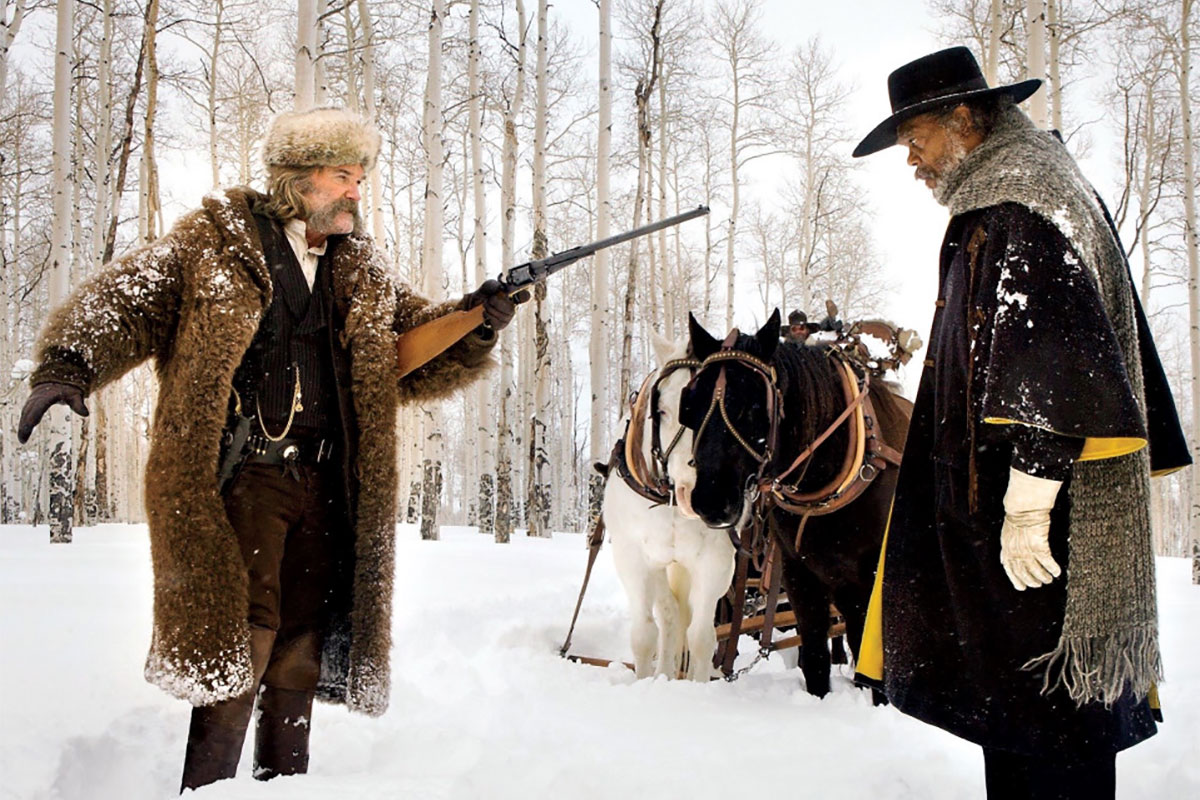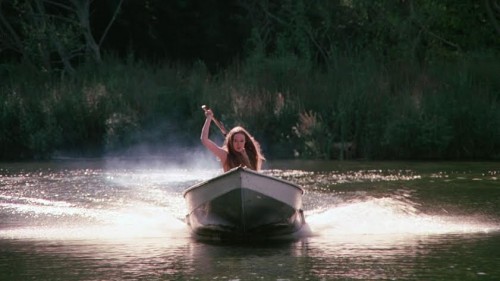This guest post is written by Sophie Besl.
[Trigger warning: discussion of rape, sexual assault and graphic violence] | Spoilers ahead.
When the only female character in Quentin Tarantino’s new film, The Hateful Eight, appeared on promotional materials, and eventually onscreen, with a black eye and chained to a male character, the hair on everyone’s backs was already up. A Tarantino fan and writer I admire went so far as to post on Facebook, “…What I saw tonight in 70 millimeter was a woman-hating piece of trash.”
In this analysis, I ask viewers and readers to take a new perspective. In an action movie, violence is due to befall all characters. Is violence against any female character inherently woman-hating, inherently misogynist?
The Hateful Eight Is a Western.
This male-centric genre, like many others, is guilty of shackling a limited number of women into stereotypical roles such as: a) emotional, submissive frontier wives completely at the mercy of men’s decisions, b) hyper-sexualized sex workers, or c) exoticized depictions of Native and Indigenous women. Of course, there are still standout roles for women (Madeline Kahn in Blazing Saddles, Katharine Ross in Butch Cassidy and the Sundance Kid, the role of Mattie in True Grit), but these roles are difficult to etch out. I would like to submit that Daisy Domergue, played by Jennifer Jason Leigh, is one of these strong roles. Tarantino gets as close as he can to putting a woman in a leading role (which he has shown is his preference in Jackie Brown, Kill Bill, Death Proof, and Inglourious Basterds).
The primary message of The Hateful Eight is about the Civil War and what it meant for America and the men, white and Black, who fought it. Thus, the main characters fought in the war. While a small number of women disguised themselves as men and fought, the overwhelming majority of veterans were men. So since the main characters had to be veterans, these were male, but Tarantino made the “next available” lead character female. Domergue is essentially the third lead, the highest level available that is historically accurate for a woman, given Tarantino’s primary goal exploring race relations (her Golden Globe nomination is for supporting actor, but it’s okay, those decisions are not a science!).
Play the Movie in Your Mind with a Male Actor in the Role.
In my opinion, one test of whether a character is feminist or not is if you ask, “Does this character’s gender play any part in the character’s actions, fate, or treatment?” If the answer is “no” or “not really, not essentially,” then that is a very feminist character. Insert a male actor in place of Jennifer Jason Leigh. Think about it — the plot would play out exactly the same. Not only that, but almost no lines of dialogue would need to be changed. “This woman” would be replaced with “this man,” “sister” with “brother,” etc. The only outlier is the dreaded “b” word, but Tarantino has plenty of colorful insults for all manner of characters.
Domergue Is Never Viewed in a Sexual or Objectifying Way.
This is rooted one of my favorite things about Tarantino as a filmmaker. In a world riddled with rape, the last thing we need is gratuitous, titillating visuals, filmed from a male point of view, of sexual violence against women.¹ The closest Tarantino ever comes to this is with the Bride² — but the sexual violence is implied not shown³ — and Death Proof, where the revenge equally or far outweighs the initial gender-based homicide. On the flip side, Tarantino has no problem showing rape and sexual assault against men onscreen, such as in Pulp Fiction and The Hateful Eight.
Shosanna in Inglourious Basterds is one of the best examples of Tarantino writing for women as if they do not live in danger of sexual violence from men. This suspension of disbelief onscreen is refreshing and empowering for viewers, such as me as a woman who does somewhat live in daily fear of sexual violence. Shosanna repeatedly, assertively turns down advances from Zoller quite at her own peril throughout the entire film. Her fearlessness is astounding, and respected. Here are the ways that Domergue is written in similarly feminist ways:
[Spoilers follow.]
• She is walked into a log cabin in the middle-of-nowhere Wyoming to spend the night with 9 or 10 men, one of whom she is chained to, and it never seems to the viewer that she might be in danger, of sexual violence or even significant other harm.
• There is no implication that her captor has raped or sexually assaulted her.
• Her looks are never commented upon, neither that she is pretty nor looking haggard. The comment-ability of her appearance intensifies over time based on the chaos that occurs inside the cabin, yet no one comments. This is impossibly refreshing and almost unheard of for women in film. Even the looks of the strongest women characters in other Westerns are usually remarked upon or up for discussion among the men.
• Domergue is not a love interest of any of the characters.*
• Men are willing to risk their lives to save Domergue due to familial or gang ties, not out of love, affection, or sexually driven motives.*
• The camera never rests on her in an objectifying or gazing way that is different than the other characters or unique to her as a woman.
*Note: Major Marquis Warren does imply this in one line of dialogue, but it is quickly dismissed. Compared to most films where men only act out of love for women and sex is a major motivator, this is still a major step in terms of feminist film.
Okay Yes, We’ll Talk about the Violence.
I’m no fool — I’m not going to pretend that it’s all butterflies and rainbows for Domergue in The Hateful Eight. As Leigh told The Daily Beast, she took a photo of herself and sent it to her mom when her only makeup was a black eye and a few scratches and bruises and said, “This is as good as it’s going to get. This is the beauty shot from the movie. … Then it just got more and more insane as it goes on.”
My initial question was: Is any violence against a woman inherently misogynist? Leigh said in an interview:
“I think it’s actually more of a sexist response [to say that]… I think it’s easy to have a sexist response. ‘Hitting a woman? Sexist.’ It’s a natural go-to place for people. But [Tarantino]’s actually taking the sexism out of it.”
Another argument about the violence is that Domergue has almost full agency over it. She has been arrested by an officer of the court, and he has made it clear what the consequences are for what actions. She purposely violates his rules, knowing what the consequences will be, and chooses the risks of receiving an elbow to the face for getting in some fantastic jabs at Kurt Russell’s character John Ruth, such as that his intelligence may have suffered from taking a high dive into a low well.
Also, while many would argue that Domergue gets the worst of the violence, mostly marked by her lack of wiping blood off of her face, it should be noted that part of the lead protagonist Major Warren’s genitals are separated from his body by a gunshot wound, an injury he viscerally suffers from until the end of the movie, so it’s not like Tarantino spares his lead male actors.
She Kills Her Captor.
While: a) being chained to Ruth, b) Ruth is poisoned and thus vomiting on her, and c) Ruth is still managing to beat her up, Domergue manages to grab his gun and blow him away. Any one of the “hateful eight” could have easily killed Ruth plot-wise, but Tarantino gives this murder to Domergue, who deserves it and has truly earned it. (Note: She also deftly and matter-of-factly saws his arm — which she’s still handcuffed to — off of his corpse to facilitate her mobility later that night.)
The Fates of Four Men Rest on Her in the End.
Speaking of her being a total badass, after Jody’s murder, she goes from being the #2 to the #1 leader of one of the most dangerous gangs in the land. In the final act of the film, she just about single-handedly negotiates the lives (and deaths) of the two protagonists and her two remaining gang members. She is unarmed, and yet commands full power over the four men’s actions and decisions until the very last moment. Her brilliance —“She’s very, very smart,” Leigh tells The Daily Beast — causes her to outshine all of the other characters and almost “win.” “…She’s a leader. And she’s tough. And she’s hateful and a survivor and scrappy,” says Leigh in an interview with Variety, all traits that give Domergue power in the frenetic, desperate situation in which all the characters find themselves.
The Death Scene.
This is arguably the most problematic scene of all. Let’s present what I’m up against before I present my counterpoint. Matt Zoller Seitz at RogerEbert.com writes:
“The film’s relentless and often comical violence against Daisy never feels truly earned. Saying, ‘Well, they’re all outlaws, including her, and that’s just how women were treated back then’ feels like an awfully thin defense when you hear audiences whooping it up each time Russell punches Leigh in the face, and it dissipates during the final scene, which lingers on Daisy’s death with near-pornographic fascination. In a movie filled with selfish, deceptive and murderous characters, hers is the only demise that is not just observed, but celebrated.”
Well this is where I’m going to go way out on a limb and repeat what Leigh herself (the woman who had to sit around in 30 degrees in the fake blood and brains, and pretend to be hung) said, “I think it’s actually more of a sexist response [to say that].” Why is watching a villain get what’s coming to her “near-pornographic fascination?” There’s nothing sexual about the act of killing her, or its filming/gaze. Also, after her death, her body is sometimes held in the same shot with the two protagonists, as if her character still lives on in a way.
• Did this reviewer feel the same way when Tarantino’s three protagonists were kicking the living bejesus out of Russell’s character in Death Proof?
• What about when Elle is sitting over Bud’s snake-poison-filled body in Kill Bill Vol. 2 and calmly reading to him? If anything, that is more tortuous and sick, plus the camera is looking up at Elle (murderer) and down at Bud (victim). These camera angles are reversed in Domergue’s murder, with an upward shot on her and downward at the murderers.
• If I recall correctly, the audience also “whooped it up” each time significant discomfort befell almost any of the characters: O.B. getting really cold, Ruth and O.B. throwing up from poison, Mannix getting shot and passing out, etc.
• If I recall correctly, the audience pretty clearly celebrated or enjoyed the shorter-in-duration but also gristly murders of Bob and Jody. This violence was also slated as comical.
• Maybe I was the only sick person in the theater, but I also found it pretty enjoyable and hilarious that Tim Roth’s character didn’t die right away, and he was crawling around in the background while a bunch of other stuff was going on, with no one paying him any mind.
• May I take a moment to reiterate the violence to Major Warren’s genitals? This was extremely comical to the audience — why is his violence earned but hers is not?
• There are only a few murders in the film that are decidedly not celebrated and those are of three women (and two men, one of whom is an older man in his 70s).
I see the temptation to look at what happens to Daisy Domergue on-screen and denounce, “You sexist, you’re destroying a woman, how misogynist!” I even did it for moments myself. However, I encourage everyone to move past this knee-jerk reaction. It’s possible that subconscious sexism makes people quick to see her as a victim, and then criticism of the trope of women as victims may be getting in the way of seeing the agency and complexity of a character like Domergue. I’d rather we not take this as an opportunity to put down Tarantino, but as an opportunity to celebrate Leigh’s nuanced and powerful performance – she even took time to learn to play guitar to perform a song in the film — as film critics are doing this awards season.
I’ll close with a quote from Tarantino:
“Violence is hanging over every one of those characters like a cloak of night. So I’m not going to go, ‘OK, that’s the case for seven of the characters, but because one is a woman, I have to treat her differently.’ I’m not going to do that.”
Notes:
[1] See my view on the only acceptable treatment of sexual violence in film in “I’ll Make You Feel Like You’ve Never Felt Before”: Jennifer’s Power in I Spit on Your Grave
[2] See a thoughtful exploration of the Bride’s rape revenge in Revenge Is a Dish Best Served… Not at All?. I agree with Rodriguez’s interpretation that Buck is “at the bottom of the barrel” as the first to die, but I disagree that Tarantino sees this is a means of empowerment that enables her to find liberation. I see it as another brutalization by Bill (indirectly) that further justifies her revenge. The Bride’s revenge against Bill feels very “tit for tat” in the way historically all-male cast movies are written, yet by working in the rape and the losing of her baby, he makes them more true to the realities of what a female character would face (again without showing sexual violence). Writing a female character with completely equal respect as a male character, yet with these realistic modifications based on gender, is the most feminist thing I can imagine.
[3] This argument of “implied not shown” was used to justify a reason why Mad Max: Fury Road is a feminist film.
See also: Revenge of the Pussycats: An Ode to Tarantino and His Women, True Romance or How Alabama Whitman Started the Fall of Damsels in Distress, Unlikable Women Week: The Roundup.
Sophie Besl is an exploitation film fanatic with a day job in nonprofit marketing. She has a Bachelor’s from Harvard and lives in Boston with three small dogs. She tweets at @rockyc5.








